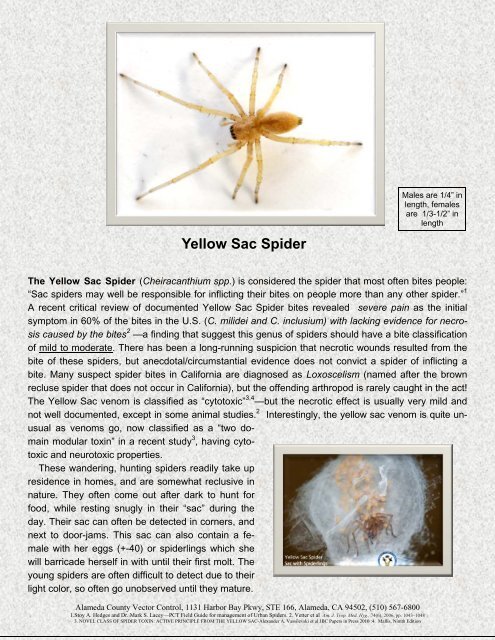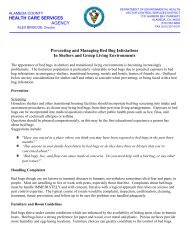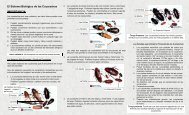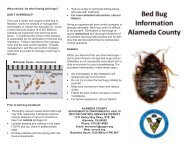Yellow Sac Spider - Vector Control Services - Alameda County
Yellow Sac Spider - Vector Control Services - Alameda County
Yellow Sac Spider - Vector Control Services - Alameda County
Create successful ePaper yourself
Turn your PDF publications into a flip-book with our unique Google optimized e-Paper software.
<strong>Yellow</strong> <strong>Sac</strong> <strong>Spider</strong><br />
Males are 1/4” in<br />
length, females<br />
are 1/3-1/2” in<br />
length<br />
The <strong>Yellow</strong> <strong>Sac</strong> <strong>Spider</strong> (Cheiracanthium spp.) is considered the spider that most often bites people:<br />
“<strong>Sac</strong> spiders may well be responsible for inflicting their bites on people more than any other spider.” 1<br />
A recent critical review of documented <strong>Yellow</strong> <strong>Sac</strong> <strong>Spider</strong> bites revealed severe pain as the initial<br />
symptom in 60% of the bites in the U.S. (C. milidei and C. inclusium) with lacking evidence for necrosis<br />
caused by the bites 2 —a finding that suggest this genus of spiders should have a bite classification<br />
of mild to moderate. There has been a long-running suspicion that necrotic wounds resulted from the<br />
bite of these spiders, but anecdotal/circumstantial evidence does not convict a spider of inflicting a<br />
bite. Many suspect spider bites in California are diagnosed as Loxoscelism (named after the brown<br />
recluse spider that does not occur in California), but the offending arthropod is rarely caught in the act!<br />
The <strong>Yellow</strong> <strong>Sac</strong> venom is classified as “cytotoxic” 3,4 —but the necrotic effect is usually very mild and<br />
not well documented, except in some animal studies. 2 Interestingly, the yellow sac venom is quite unusual<br />
as venoms go, now classified as a “two domain<br />
modular toxin” in a recent study 3 , having cytotoxic<br />
and neurotoxic properties.<br />
These wandering, hunting spiders readily take up<br />
residence in homes, and are somewhat reclusive in<br />
nature. They often come out after dark to hunt for<br />
food, while resting snugly in their “sac” during the<br />
day. Their sac can often be detected in corners, and<br />
next to door-jams. This sac can also contain a female<br />
with her eggs (+-40) or spiderlings which she<br />
will barricade herself in with until their first molt. The<br />
young spiders are often difficult to detect due to their<br />
light color, so often go unobserved until they mature.<br />
<strong>Alameda</strong> <strong>County</strong> <strong>Vector</strong> <strong>Control</strong>, 1131 Harbor Bay Pkwy, STE 166, <strong>Alameda</strong>, CA 94502, (510) 567-6800<br />
1.Stoy A. Hedges and Dr. Mark S. Lacey—PCT Field Guide for management of Urban <strong>Spider</strong>s. 2. Vetter et al Am. J. Trop. Med. Hyg., 74(6), 2006, pp. 1043–1048<br />
3. NOVEL CLASS OF SPIDER TOXIN: ACTIVE PRINCIPLE FROM THE YELLOW SAC-Alexander A. Vassilevski et al JBC Papers in Press 2010 :4. Mallis, Nimth Edition
<strong>Yellow</strong> <strong>Sac</strong> <strong>Spider</strong> Chew Marks on Zip Sealable Plastic Bag<br />
Observations 5<br />
This is a sealable plastic bag (Ziploc) that a <strong>Yellow</strong> <strong>Sac</strong> spider was placed in one evening, but had<br />
chewn it’s way out of by morning time. This was the second time this feat occurred by the able <strong>Yellow</strong><br />
<strong>Sac</strong> spider—escaping in the night. This is the only spider, over the years to chew it’s way out of a<br />
plastic bag (authors observation). Other captive spiders, such as Black Widow, Wolf, Cellar, Orb<br />
Weaver, Trap Door, Jumping <strong>Spider</strong>s and Wind Scorpions have pined for their freedom through the<br />
night, but never put their mandibles to work to affect an escape!<br />
Other interesting observations have been made regarding this spider, like curling up into a ball and<br />
dropping to the ground when molested while crawling on a wall—they seem to be an expert in the<br />
“quick-drop” and escape! Also, these spiders seem fairly flexible and are able to squeeze out of what<br />
would normally seem to be a small opening (air hole) in a plastic container. And speaking of the quick<br />
drop; this spider made me a believer in using a “motion detector” for the porch light, when one evening<br />
I was entering my front door, something dropped on my neck, which I promptly whacked, and the <strong>Yellow</strong><br />
<strong>Sac</strong> spider was crushed by my blow! I did not feel a bite, but in the morning I had a small bump that<br />
over the next few days developed into a pimple-like blister, that actually took months to completely<br />
heal, and would occasionally break open and bleed. My dear doctor offered to excise the wound site,<br />
but since it was but painful, only annoying, I let it heal on it’s own. Oh yes—the small crickets that I<br />
feed to the other spiders, kill the <strong>Yellow</strong> <strong>Sac</strong> spiders… go figure!<br />
5. Observations by Daniel Wilson ACVCDS







